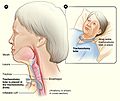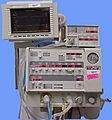Tracheotomy facts for kids
Tracheotomy and tracheostomy are medical procedures that help people breathe. They involve creating a small opening in the front of the neck. This opening goes directly into the trachea, which is also known as the windpipe. This new path allows air to reach the lungs when the usual airway is blocked or damaged.
Doctors, surgeons, and paramedics perform these procedures. They are done when someone cannot breathe properly on their own.
Contents
The History of Tracheostomy
People have known about tracheostomy for a very long time. Ancient Egyptian tablets mention similar ideas.
In the 12th century, a doctor named Ibn Zuhr described the first correct tracheotomy operation. He used it to help people who were suffocating and could not breathe.
Later, in 1909, an American doctor named Chevalier Jackson described the modern tracheostomy. His methods helped make the procedure safer and more common.
Why is a Tracheostomy Needed?
A tracheostomy is needed when someone cannot breathe well through their nose or mouth. This can happen for several reasons:
- Blocked Airway: Sometimes, something blocks the windpipe, like a serious injury or a large swelling.
- Breathing Problems: People with certain illnesses might need help breathing for a long time. A tracheostomy can connect them to a breathing machine.
- Protecting the Lungs: If someone has problems swallowing, food or liquid might go into their lungs. A tracheostomy can help protect the lungs from this.
How is a Tracheostomy Performed?
The procedure is a type of surgery. It is usually done in a hospital.
- First, the patient is given medicine to make them sleep and not feel pain.
- Then, a small cut is made in the front of the neck.
- A small opening is carefully made in the windpipe.
- A special tube, called a tracheostomy tube, is placed into this opening. This tube allows air to flow directly into the lungs.
- The tube is then secured so it stays in place.
Living with a Tracheostomy
People with a tracheostomy can often learn to speak and eat normally. Special valves can be added to the tube to help with speaking. Nurses and doctors teach patients and their families how to care for the tracheostomy tube. This includes keeping it clean and clear.
The tracheostomy can be temporary or permanent. If the original breathing problem gets better, the tube can sometimes be removed. The opening in the neck will then close on its own.
Images for kids
-
Tracheotomy tubes and endotracheal tubes are often attached to ventilators to assist in breathing.
-
Completed tracheotomy:
1 - Vocal cords
2 - Thyroid cartilage
3 - Cricoid cartilage
4 - Tracheal cartilages
5 - Balloon cuff.
See also
 In Spanish: Traqueotomía para niños
In Spanish: Traqueotomía para niños








